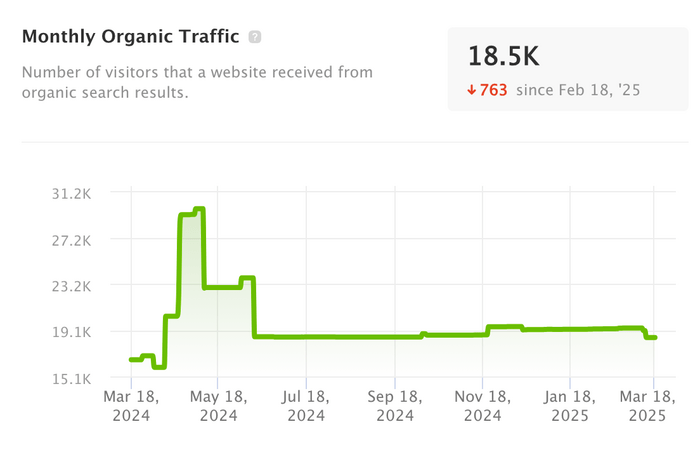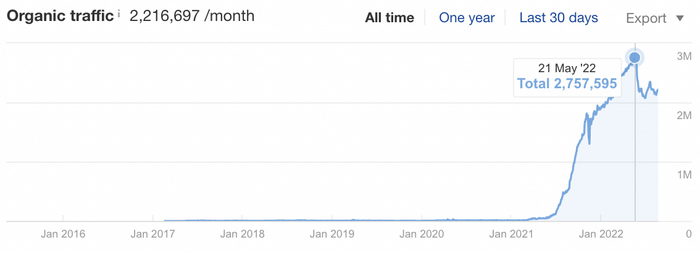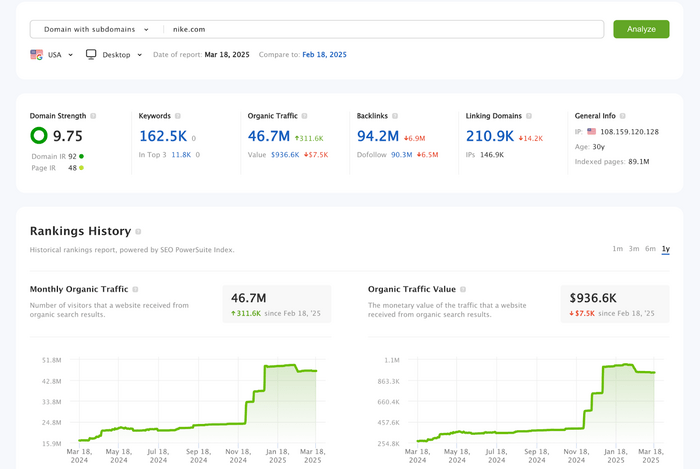The Ultimate Guide to SEO for Startups

Contents
- What is SEO for startups?
- 7 compelling reasons why startups need to invest in SEO
- How to kickstart your startup SEO strategy: Quick check of your status quo
- Step 1: Define clear SEO objectives aligned with your startup’s goals
- Step 2. Conduct an in-depth customer needs assessment
- Step 3. Set up a solid technical SEO foundation
- Step 3. Perform keyword research driven by user intent
- Step 4. Produce versatile, high-value pillar content
- Step 5. Develop a robust internal linking strategy
- Step 6. Perform competitor SEO analysis without simply copying
- Step 7. Measure performance, learn, and iterate regularly
- Wrapping it up
When launching a startup, you're likely focused on building your product, perfecting your business model, and growing a customer base.
However, there's one powerful growth lever many startups overlook at first: search engine optimization. If you're serious about sustainable growth, your startup must prioritize SEO from day one.
But why exactly is SEO crucial for startups? And how can a young company without an established online presence compete against established industry giants?
In today's comprehensive guide, I'll walk you through the fundamentals of SEO specifically tailored for startups. You'll learn actionable strategies to boost visibility, attract organic traffic, and sustainably grow your startup's online presence without a massive budget.
Let's dive in!
What is SEO for startups?
SEO for startups is the practice of optimizing your startup’s website and content to appear higher in search engine results pages (SERPs), helping potential customers easily find your business online. Effective startup SEO typically involves:
- Strategic keyword research
- Creating valuable, user-focused content
- Optimizing your website’s structure and performance
- Technical SEO improvements (site speed, mobile-friendliness, security)
- Building quality backlinks to increase authority
For startups, SEO provides an affordable way to drive sustainable organic traffic, compete with established brands, and build credibility with both search engines and users—without depending solely on paid advertising.
7 compelling reasons why startups need to invest in SEO
SEO isn't just another marketing buzzword—it's a foundational strategy that can differentiate your startup and set you on a path toward sustainable growth.
Here are seven unique reasons why investing in SEO is especially beneficial for startups:
1. SEO future-proofs your startup's growth
Many startups focus heavily on short-term "growth hacks," but SEO lays the groundwork for lasting success. Unlike paid advertising, which stops delivering results once your budget is depleted, SEO provides steady, compounding growth.
Consider evergreen content—blog posts that remain relevant for years.
For instance, an e-commerce startup publishing a well-optimized guide like "How to choose the right shoe size online" could continuously attract new customers without additional spending. Each new visitor has the potential to convert, building value over time.
According to HubSpot's Blog Research, blog content consistently generates one of the highest returns on investment for businesses, underscoring SEO’s effectiveness as a long-term growth channel.
2. SEO enables startups to gain an edge in emerging markets
For startups entering new or emerging niches, SEO presents an opportunity to establish a foothold before larger competitors saturate the market. By strategically targeting low-competition keywords, startups can quickly establish visibility and credibility.
A compelling example is the Peanut App, where the startup’s SEO lead, Dimitris Drakatos, successfully scaled the company's organic traffic to 2.3 million visitors within just 12 months. By tapping into niche search queries, Peanut rapidly became a market authority, demonstrating the potential of targeted SEO in emerging sectors.
3. SEO enhances the performance of paid advertising
SEO and paid advertising (like Google Ads) aren't rivals; they're complementary strategies. When your startup's website ranks organically, it naturally gains trust with users. As a result, your paid ads perform better due to increased brand credibility, driving higher click-through rates (CTR) and conversions.
Think of paid ads as a quick sprint, while SEO acts as a marathon. Over time, strong SEO can reduce dependency on paid channels, allowing for more efficient and impactful ad campaigns when you do invest.
4. SEO drives high-quality, informative content creation
Effective SEO pushes startups to produce content that genuinely benefits users. Google's algorithm prioritizes "people-first content"—content created primarily to educate or inform real people, rather than to merely rank in search results.
When startups consistently address real customer pain points and answer key questions, it builds lasting credibility. Creating useful content not only pleases Google but also earns customer trust and fosters long-term loyalty.
This user-centric approach aligns with Google's core advice:
We recommend that you focus on creating people-first content to be successful with Google Search, rather than search engine-first content made primarily to gain search engine rankings.
Writing with your customers in mind first, then optimizing for search engines second, results in greater customer satisfaction, increased trust, and stronger brand loyalty.
5. SEO adds value at every stage of the customer journey
One of SEO’s greatest strengths is its ability to engage customers at all stages of their journey, from initial awareness through post-purchase loyalty.
At the awareness stage, SEO-optimized content introduces your brand to prospective customers conducting preliminary research.
For example, a sustainable packaging startup could rank for "Why sustainable packaging matters," attracting eco-conscious consumers who aren’t yet ready to purchase.
During the interest and desire stage, SEO provides informative content such as product comparisons, reviews, and case studies. Given that 60% of consumers perform online research before purchasing, visibility here is critical.
At the action stage, SEO-driven content like in-depth FAQs, tutorials, and detailed use cases help convert hesitant users by addressing their final questions or objections.
Importantly, SEO’s impact doesn’t end with a sale. After purchase, content such as ongoing tutorials, updates, or tips keeps customers engaged, promoting long-term retention and repeat business.
6. SEO helps startups build stronger brand recognition
When startups consistently appear in relevant search results, it enhances brand recognition and recall. Ranking for strategic keywords means users repeatedly encounter your brand when searching for industry-related information, reinforcing your market presence.
Unlike traditional advertising, which can feel intrusive, SEO places your startup in front of users actively seeking solutions, increasing positive associations with your brand. Over time, consistent visibility via SEO translates to increased market awareness, authority, and a stronger competitive position.
7. SEO provides valuable market insights and customer data
An often-overlooked benefit of SEO is the wealth of market insights it provides. By regularly analyzing SEO data, startups can better understand what their customers care about, how they search, and what motivates their decisions.
Tools like Google Analytics and SEO PowerSuite's Rank Tracker reveal key insights into audience interests, content preferences, and market trends.
Armed with this actionable data, startups can make smarter decisions across product development, content strategy, and overall marketing—ensuring their offerings stay aligned with customer needs and preferences.
How to kickstart your startup SEO strategy: Quick check of your status quo
Before diving deep into tactics, assess your current SEO situation. An effective and easy tool for startups is Rank Tracker’s Domain Analysis. Quickly audit your website to view key SEO insights:
- Organic keyword rankings
- Visibility and traffic potential
- Competitor performance comparisons
- Keyword opportunities you might've missed
A quick analysis guides your initial strategy, revealing strengths and weaknesses, and helps prioritize the next steps.
Step 1: Define clear SEO objectives aligned with your startup’s goals
Many startups begin creating content without clearly defining why they're doing it. They jump directly into production, trying to anticipate customer queries, yet they often overlook critical internal objectives and strategic alignment.
Before crafting a single word, take a step back and clarify your goals. Gather stakeholders from your marketing, sales, product, and leadership teams and collaboratively answer these key questions:
- What core business objectives does our content support?
- What internal needs or priorities are we addressing?
- What specific outcomes do we hope to achieve through SEO?
Clearly defining these objectives transforms SEO from an isolated activity into a powerful driver of business growth. For instance:
- If your goal is market awareness, create content focused on emerging trends and big industry questions.
- If your objective is boosting product adoption, prioritize content that educates and engages users directly around your product’s value.
Aligning SEO with strategic goals turns content creation into a meaningful business investment, accelerating your startup’s trajectory.
Step 2. Conduct an in-depth customer needs assessment
SEO efforts can fall flat if you base your decisions on guesswork or assumptions. To create truly impactful content, dig deep into understanding your audience’s motivations, challenges, and needs.
As Dimitris Drakatos, SEO Lead at Peanut App (who drove their organic traffic to 2.3 million monthly visits), emphasizes:
If you don’t deeply understand your audience’s needs, you’re essentially gambling with your resources, hoping something resonates.
To thoroughly analyze customer needs, start with these essential steps:
- Identify your ideal audience: Who are they, and what professional roles or personal characteristics define them?
- Uncover pain points: What key problems, frustrations, or challenges do they face?
- Pinpoint common queries: What specific questions are they typing into Google to address these pain points?
- Recognize purchasing behaviors: Understand how and why they choose products or services, and the criteria that matter most to them.
When your content directly addresses customer needs, it naturally resonates better—driving engagement, trust, and conversions.
Step 3. Set up a solid technical SEO foundation
Even outstanding content won’t perform if search engines can't properly crawl and index your site. Technical SEO is essential for optimal visibility and involves ensuring your website is fast, secure, and well-structured.
Prioritize these critical technical elements:
- Responsive design: Ensure your website looks and functions perfectly across mobile and desktop.
- Website speed optimization: Measure loading performance (use tools like Google PageSpeed Insights) and fix issues to improve load times.
- SSL security (HTTPS): Protect your visitors’ information; Google favors secure sites.
- XML sitemap: Submit an XML sitemap to Google Search Console, helping search engines index your pages effectively.
- Structured data (schema markup): Implement schema to enhance your visibility in SERPs through rich snippets.
- Internal linking: Create logical links to guide users and crawlers seamlessly through your site.
- Core Web Vitals: Focus on improving LCP (Largest Contentful Paint), FID (First Input Delay), and CLS (Cumulative Layout Shift). Use Google’s PageSpeed Insights to test your pages.
Regularly reviewing these elements helps maintain strong search performance and user experience, laying a foundation that supports your ongoing content marketing.
Step 3. Perform keyword research driven by user intent
Ranking for keywords that don't align with user intent leads to traffic that doesn't convert. Align your SEO strategy with user intent to attract visitors who are more likely to become customers.
Here’s how to target intent-driven keywords:
- Classify user intent clearly: Understanding user intent helps you select the right keywords.
- Target long-tail keywords: They have less competition and higher conversion potential. For example, "SEO tools for startup e-commerce brands" instead of broad terms like "SEO software."
- Leverage keyword research tools: Use Rank Tracker to uncover valuable intent-driven keyword opportunities with manageable competition levels.
This targeted approach optimizes your SEO resources and ensures you attract high-quality, engaged visitors at every stage of their buyer’s journey.
Step 4. Produce versatile, high-value pillar content
Producing pillar content—extensive, comprehensive guides or resources—helps establish your startup as a thought leader. Such content provides lasting value and can serve as a basis for multiple content types.
Follow these steps:
- Identify your core topics: Select key challenges, needs, or frequently asked questions by your audience.
- Create in-depth pillar content: Produce comprehensive guides, whitepapers, or detailed case studies that thoroughly address these topics.
For example, a project management software startup could produce a pillar guide titled, "The Ultimate Guide to Effective Remote Team Management."
Then repurpose this valuable content into multiple formats, such as:
- Blog series: Extract and expand sections into separate blog posts optimized for related keywords.
- Educational videos: Create short videos summarizing core concepts for platforms like YouTube.
- Social media content: Break down insights into shareable visuals, tips, or threads for LinkedIn or Twitter.
- Infographics: Summarize key points visually, making your insights easy to digest and share.
This approach multiplies your content’s impact, reaching audiences across diverse channels while maximizing return on your initial content investment.
Step 5. Develop a robust internal linking strategy
Internal links often get overshadowed by backlinks, yet they’re crucial for helping search engines and users navigate your site effectively. A strategic internal linking approach boosts rankings, enhances user experience, and supports your content ecosystem.
Follow these best practices:
- Prioritize high-value pages: Link frequently to your pillar content, key service pages, or conversion-oriented landing pages.
- Use descriptive anchor text: Choose anchors clearly indicating the linked page’s content (e.g., "best SEO tips for startups" rather than "click here").
- Create clear content hierarchy: Organize links logically from broad topics (pillar pages) to more detailed subtopics, creating a user-friendly structure.
A clear internal linking strategy amplifies SEO results, improves crawlability, and ensures your visitors find relevant content easily, increasing time spent on your site.
Step 6. Perform competitor SEO analysis without simply copying
Analyzing your competitors' SEO strategies can reveal valuable insights—but the goal isn’t imitation; it's differentiation.
Here's how you can intelligently analyze competitor SEO data:
- Identify competitors' top-performing content: Use SEO tools to find pages driving the most traffic for competitors. Analyze themes, structure, and depth.
- Evaluate keyword gaps: Identify high-potential keywords your competitors have missed.
- Recognize opportunities to outperform: Spot weaknesses—poor user experience, shallow content, outdated information—and leverage these opportunities by creating superior, more engaging content.
Rather than copying competitors directly, use insights as inspiration for unique content that delivers greater value, aligning closely with your startup’s unique selling points.
Step 7. Measure performance, learn, and iterate regularly
Effective SEO isn't a "set-and-forget" strategy; it requires ongoing measurement, analysis, and adjustments.
Regularly monitor these crucial metrics:
- Organic traffic and conversions: Track visitors and leads from organic search.
- Keyword ranking: Measure your ranking positions regularly.
- Engagement metrics: Watch bounce rate, session duration, and click-through rates.
- Technical site health: Perform regular audits using tools like SEO PowerSuite’s WebSite Auditor or Google Search Console.
Then, use your insights to:
- Identify successful patterns: Recognize the content and strategies delivering the best results, and replicate them.
- Diagnose problems quickly: Detect drops in rankings or traffic to pinpoint and fix issues rapidly.
- Continuously experiment: Test new content formats, topics, and SEO strategies to adapt to changing trends and algorithm updates.
This iterative approach ensures your SEO strategy evolves with your startup’s growth, continuously driving sustainable results.
Wrapping it up
SEO may initially seem daunting or time-consuming for startups juggling numerous tasks. However, with focused, consistent effort, SEO becomes one of your most potent growth strategies. It provides a long-lasting, cost-effective way to attract and convert visitors without relying solely on paid ads.
Start small, begin with low-competition keywords, produce consistent valuable content, and regularly analyze performance. Over time, these incremental steps accumulate, allowing your startup to achieve sustained growth and stand out in crowded markets.
By making SEO a strategic priority from day one, you're setting your startup up not just for early visibility—but for sustainable, scalable, long-term success.








